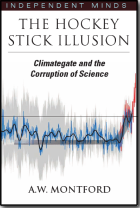Matt Ridley reviews The Hockey Stick Illusion by Andrew Montford – author of the “Bishop Hill” blog:
Andrew Montford’s The Hockey Stick Illusion is one of the best science books in years. It exposes in delicious detail, datum by datum, how a great scientific mistake of immense political weight was perpetrated, defended and camouflaged by a scientific establishment that should now be red with shame. It is a book about principal components, data mining and confidence intervals—subjects that have never before been made thrilling. It is the biography of a graph.
I can remember when I first paid attention to the “hockey stick” graph at a conference in Cambridge. The temperature line trundled along with little change for centuries, then shot through the roof in the 20th century, like the blade of an ice-hockey stick. I had become somewhat of a sceptic about the science of climate change, but here was emphatic proof that the world was much warmer today; and warming much faster than at any time in a thousand years. I resolved to shed my doubts. I assumed that since it had been published in Nature—the Canterbury Cathedral of scientific literature—it was true.
The temperature line trundled along with little change for centuries, then shot through the roof in the 20th century, like the blade of an ice-hockey stick. I had become somewhat of a sceptic about the science of climate change, but here was emphatic proof that the world was much warmer today; and warming much faster than at any time in a thousand years. I resolved to shed my doubts. I assumed that since it had been published in Nature—the Canterbury Cathedral of scientific literature—it was true.
I was not the only one who was impressed. The graph appeared six times in the Intergovernmental Panel on Climate Change (IPCC)’s third report in 2001. It was on display as a backdrop at the press conference to launch that report. James Lovelock pinned it to his wall. Al Gore used it in his film (though describing it as something else and with the Y axis upside down). Its author shot to scientific stardom. “It is hard to overestimate how influential this study has been,” said the BBC. The hockey stick is to global warming what St Paul was to Christianity.
…
A retired mining entrepreneur with a mathematical bent, [Steve] McIntyre asked the senior author of the hockey stick graph, Michael Mann, for the data and the programs in 2003, so he could check it himself. This was five years after the graph had been published, but Mann had never been asked for them before. McIntyre quickly found errors: mislocated series, infilled gaps, truncated records, old data extrapolated forwards where new was available, and so on.
Not all the data showed a 20th century uptick either. In fact just 20 series out of 159 did, and these were nearly all based on tree rings. In some cases, the same tree ring sets had been used in different series. In the end the entire graph got its shape from a few bristlecone and foxtail pines in the western United States; a messy tree-ring data set from the Gaspé Peninsula in Canada; another Canadian set that had been truncated 17 years too early called, splendidly, Twisted Tree Heartrot Hill; and a superseded series from Siberian larch trees. There were problems with all these series: for example, the bristlecone pines were probably growing faster in the 20th century because of more carbon dioxide in the air, or recovery after “strip bark” damage, not because of temperature change.
This was bad enough; worse was to come. Mann soon stopped cooperating, yet, after a long struggle, McIntyre found out enough about Mann’s programs to work out what he had done. The result was shocking. He had standardised the data by “short-centering” them—essentially subtracting them from a 20th century average rather than an average of the whole period. This meant that the principal component analysis “mined” the data for anything with a 20th century uptick, and gave it vastly more weight than data indicating, say, a medieval warm spell.
Well, it happens. People make mistakes in science. Corrections get made. That’s how it works, is it not? Few papers get such scrutiny as this had. But that is an even more worrying thought: how much dodgy science is being published without the benefit of an audit by Mcintyre’s ilk? As a long-time champion of science, I find the reaction of the scientific establishment more shocking than anything. The reaction was not even a shrug: it was shut-eyed denial.
Source: Prospect
 Sign In
Sign In 0 Items (
0 Items ( Search
Search







